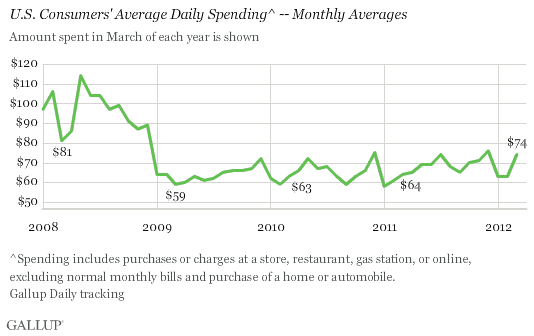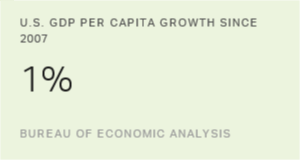PRINCETON, NJ -- Gallup's key U.S. economic indicators tell a consistent story of improving economic and behavioral conditions. Americans' self-reported employment status, personal spending, and workplace hiring trends were all better in March than in February, and were improved over March 2011, although still below pre-recession levels. In addition, Americans' ratings of the U.S. economy were at a four-year high. However, that was prior to last week's disappointing Bureau of Labor Statistics jobs report and Wall Street's latest downturn. Those events could spark another reversal like so many others that have occurred since 2009, but thus far, Gallup indicators suggest otherwise.

All of Gallup's economic indicators -- except economic confidence, which receded slightly -- improved further in the first week of April, based on interviewing ending April 8. Gallup Daily tracking in the coming days will reveal whether consumers' confidence in the economy and willingness to spend have been rattled by the more recent economic news. In the meantime, it is clear that prior to now, Gallup's economic metrics have all been pointing in a positive direction.
Employment Slowly Headed in Right Direction
Gallup measures the national labor situation in two ways. One is a direct measure of U.S. adults' employment status, producing Gallup's national unemployment and underemployment rates. The second is based on employed Americans' characterization of whether their workplace is adding or shedding jobs, summarized in Gallup's Job Creation Index.
Since the inception of Gallup's unemployment metric in January 2010, unemployment has been descending at a slow rate from the initial 10.9%, while workers' reports of net hiring have been inching up. Gallup's measures of unemployment and job creation improved in March after deteriorating in February, and are now slightly better than where they stood in January. They are also significantly higher than they were a year ago, in March 2011.

Both measures show continued positive momentum in early April, with the Job Creation Index rising to +20 in Gallup's latest weekly average, from April 2-8, and unemployment dipping to 8.2% in Gallup's latest 30-day average through April 8.
Consumers Loosening Their Wallets
Americans' self-reporting of their own discretionary spending was $74 per day in March, up from $64 a year ago and the highest Gallup has recorded for March in four years. It is also near the highest spending for any month since the end of 2008. Still, consumer spending is well short of where it was in 2008, prior to the Wall Street financial crisis, indicating that consumers are still in a recovery phase.

Gallup's consumer spending measure is not seasonally adjusted, and spending does vary to some extent by month, particularly through the holiday season, when it jumps higher. Thus, year-over-year monthly comparisons are a meaningful indicator of real changes in spending.
Importantly, the $10-per-day average increase in consumer spending between March 2011 and March 2012 is the largest same-month increase Gallup has recorded since establishing this measure in January 2008. However, there was a brief period in mid-2010 when same-month spending rose each month by $6 to $9 per day, and Gallup documented consistent $5 to $7 increases in the summer and fall of 2011.
Economic Confidence Plateaus at Improved Level
The past 15 months have been volatile for Americans' confidence in the economy. Confidence started off relatively high in January 2011, spiked in May after the killing of Osama bin Laden, then descended to near-record lows in the summer amid the debt ceiling political crisis and related shocks to Wall Street. It has since shown slow but steady improvement, and in March built on those gains to reach -20, the highest monthly average for the index in over four years.
Still, confidence is now at a level that has proved a barrier in recent years. And perhaps consistent with that, confidence receded in the first week of April to -23, rather than advancing further. This may partly reflect the March BLS jobs report, released on April 6, and recent turmoil in the stock market, so it will be important to see how this indicator performs throughout the month.

As an aside, a recent Gallup analysis finds that President Barack Obama's overall job approval rating has been closely linked with Americans' confidence in the economy in recent months. Thus, his ability to reach 50% approval may depend on whether Gallup's Economic Confidence Index rises just a bit further, to perhaps -16 to -13.
Bottom Line
The rate of U.S. economic growth in the coming months could largely be determined by the pace of gains in the labor market. This may depend on increases in consumer spending, which in turn could be influenced by workers' perceptions of their job security and consumers' broader confidence in the economy.
Gallup indicators touching on all four factors remain weak in absolute terms, and in many cases remain below pre-recession levels, but were at post-recession highs in March after several months of steady improvement. And the early indications from April are that, with the exception of economic confidence, these improved readings are largely holding.
With consumers still fragile from the recent recession, any significant economic setback -- such as with unemployment, the stock market, or gas prices -- could cause another rapid reversal in confidence and spending. However, barring that, Gallup's economic metrics appear poised to finally make a significant break from their post-recession lows.
Gallup.com reports results from these indexes in daily, weekly, and monthly averages and in Gallup.com stories. Complete trend data are always available to view and export in the following charts:
Daily: Employment, Economic Confidence, Job Creation, Consumer Spending
Weekly: Employment, Economic Confidence, Job Creation, Consumer Spending
Read more about Gallup's economic measures.
View our economic release schedule.
